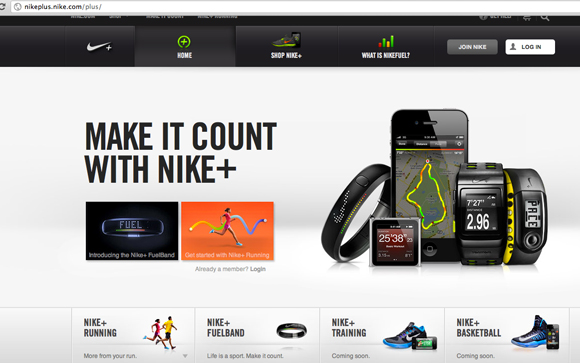For my first post, I will be looking at how sports apparel giant Nike has embraced the use of technology and digital in order to position themselves as one of the most innovative brands on the planet. Traditionally, Nike built its business through a combination of strong innovative products and intensive brand-building through multiple media. As the possibilities of new digital media emerged, Nike was fast to capitalize in these areas (Tannou & Westerman 2012).
Nike began experimenting with digital as early as 1996 with the launch of Nike.com for the Atlanta Olympics. This move was the basis for all further digital expansion with the brand (Swallow 2011). For Nike, the Internet presented a new frontier and with their already established global appeal and the brand was in a comfortable position to take advantage of emerging digital platforms (Neal 2005). Similarly, Smith (2012) noted that by taking into consideration the preferences of Millennials, the effectiveness of online communications and digital marketing aimed at this market segment can be increased. In line with this emerging trend, Nike moved into the social media space, joining platforms such as MySpace and took advantage of internet users’ affinity for sharing content and started posting videos on YouTube.
In 2010 Nike then ramped up their digital marketing efforts launching the Nike+ running app, which uses GPS technology to track users’ workout data (Neal 2014). The Nike+ Running Apps link seamlessly into nikeplus.com which Nike rebuilt from the ground up in HTML5 for a better infrastructure, faster performance and smarter capabilities (Nike 2012). The brand then released it’s first major follow-up product, the Nike FuelBand. I had contemplated buying one at this stage but couldn’t seem to get my hands on one in Ireland at the time (#sadface).
Nike stated that by using these devices, users could track their routes and share them with others in the Nike community which was pretty cool. This resulted in one of the largest databases of running routes in the world, created in just over a year (Swallow 2011). This move meant that via digital technologies, Nike could forge a tighter customer-brand relationship. This move also signaled a broader effort to shift the bulk of Nike’s marketing strategy into the digital and social media realm (Guarda 2013). Ramaswamy (2008) noted that by engaging with informed, connected, and networked customers around the globe through their digital efforts, Nike found a new source of value. When Nike launched the Nike+ (NikePlus) platform they created a co‐creation platform that capitalizes on the connection between running and music and with the combination of innovative, mobile technology, online communities and athletic gear.
I think Nike’s Global Digital Brand and Innovation Director Jesse Stollak gave an pretty interesting insight into how the brand connects with fans on a global scale stating that “Ultimately, we are about connecting with the consumer where they are, we’ve quickly evolved to a focus on conversations and engaging them to participate as opposed to using new media in traditional ways.” I personally believe that what Nike did and (is currently doing) heavily indicates the way even traditional brands will have to market themselves to new consumers in the 21st century. Nike themselves have arguably engaged one of the best uses of social media and digital marketing we have seen to connect a traditional brand to consumers and we are sure to see many brands attempt to follow suit in the near future.
References
- Cashman , J (2013) “How Nike Is Killing It In Social Media Marketing” [Online] Available at: https://digitalfireflymarketing.com/how-nike-killing-it-social-media-marketing Last Accessed 14/03/2015.
- Guarda, D. (2013) “Nike Takes Digital Data and Social Media Marketing Seriously” [Online] Available at: http://www.intelligenthq.com/social-media-business/nike-takes-digital-data-and-social-media-marketing-seriously/ Last Accessed 14/03/2015.
- Neal, C. (2014) “Case Study: Nike Regains Its Stride in the Digital Market” [Online] Available at: http://www.brittonmdg.com/case-study-nike-regains-their-stride-in-the-digital-market/ Last Accessed 14/03/2015.
- Ramaswamy, V. (2008) “Co‐creating value through customers’ experiences: the Nike case”, Strategy & Leadership, Vol. 36 Iss: 5, pp.9 – 14
- Smith, K.T. (2012) “Longitudinal study of digital marketing strategies targeting Millennials”, Journal of Consumer Marketing, Vol. 29 Iss: 2, pp.86 – 92
- Swallow , E. (2011) “How Nike Outruns the Social Media Competition” [Online] Available at: http://mashable.com/2011/09/22/nike-social-media/ Last Accessed 14/03/2015.
- Tannou , M. and Westerman, G. (2012) “Nike: From Separate Digital Initiatives to Firm-Level Transformation” Capgemini Consulting. [Online] Available at: http://www.capgemini-consulting.com/resource-file-access/resource/pdf/digital_transformation_at_nike_20-12_pdf.pdf Last Accessed 14/03/2015.


